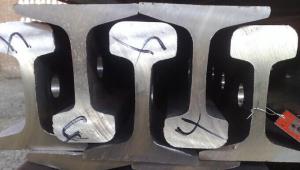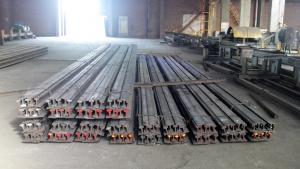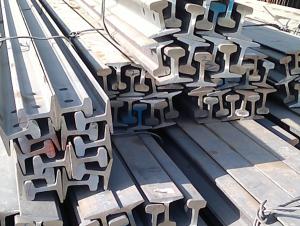Steel Light Rail Grade Q235
- Loading Port:
- China Main Port
- Payment Terms:
- TT or LC
- Min Order Qty:
- 50 m.t.
- Supply Capability:
- 5000 m.t./month
OKorder Service Pledge
OKorder Financial Service
You Might Also Like
Product Description:
OKorder is offering Steel Light Rail Grade Q235 at great prices with worldwide shipping. Our supplier is a world-class manufacturer of steel, with our products utilized the world over. OKorder annually supplies products to African, South American and Asian markets. We provide quotations within 24 hours of receiving an inquiry and guarantee competitive prices.
Product Applications:
Steel Light Rail Grade Q235 are ideal for structural applications and are widely used in forest region, Mines, factories and construction sites laid of the place such as temporary transport line and light motorcycles with line.etc.
Product Advantages:
OKorder's Steel Light Rail Grade Q235 are durable, strong, and wide variety of sizes.
Main Product Features:
· Premium quality
· Prompt delivery & seaworthy packing (30 days after receiving deposit)
· Mill test certification
· Professional Service
· Competitive pricing
Product Specifications:
Manufacture: Hot rolled
Grade: Q235, 55Q
Certificates: ISO, SGS, BV, CIQ
Length:6m, 12m,12.5m
Package: Packed in bundles and shipped by break bulk or containers.
LIGHT RAIL/HEAVY RAIL | Height (mm) | Bottom (mm) | Head width (mm) | Head height (mm) | Waist height | Bottom height (mm) | Waist thichness (mm) | Section cm2 | Mass: Kg/m |
9 | 63.50 | 63.50 | 32.10 | 17.48 | 35.72 | 10.30 | 5.90 | 11.30 | 8.94 |
12 | 69.85 | 69.85 | 38.10 | 19.85 | 37.70 | 12.30 | 7.54 | 15.54 | 12.2 |
15 | 79.37 | 79.37 | 42.86 | 22.22 | 43.65 | 13.50 | 8.33 | 19.33 | 15.2 |
22 | 93.66 | 93.66 | 50.80 | 26.99 | 50.00 | 16.67 | 10.72 | 28.39 | 22.3 |
30 | 107.95 | 107.95 | 60.33 | 30.95 | 57.55 | 19.45 | 12.30 | 38.32 | 30.1 |
FAQ:
Q1: How many tons of steel products could be loaded in containers?
A1: Usually the steel products are delivered by bulk vessel because of the large quantity and the freight. However, there are no bulk vessel enter some seaports so that we have to deliver the cargo by containers. The 6m steel product can be loaded in 20FT container, but the quantity is changed according to the size, usually from 18tons to 25tons.
Q2: How do we guarantee the quality of our products?
A2: We have established an advanced quality management system which conducts strict quality tests at every step, from raw materials to the final product. At the same time, we provide extensive follow-up service assurances as required.
Q3: How soon can we receive the product after purchase?
A3: Within three days of placing an order, we will arrange production. The normal sizes with the normal grade can be produced within one month. The specific shipping date is dependent upon international and government factors, the delivery to international main port about 45-60days.
Images:


- Q: Can steel rails be recycled after they reach the end of their lifespan?
- Yes, steel rails can be recycled after they reach the end of their lifespan. Steel is a highly recyclable material, and the recycling process involves melting down the old rails to be used in the production of new steel products. Recycling steel rails not only helps conserve natural resources but also reduces the environmental impact associated with mining and manufacturing new steel.
- Q: How do steel rails contribute to train speed maintenance?
- Several factors contribute to the maintenance of train speed, and steel rails play a crucial role in this process. Firstly, the smooth and stable surface provided by steel rails allows the train wheels to roll seamlessly, minimizing friction and enabling the train to maintain a consistent speed. This low friction also reduces wear and tear on both the train wheels and tracks, leading to less maintenance and a longer lifespan. Secondly, the strength and durability of steel rails make them capable of withstanding heavy loads and constant use. This ensures that trains can travel at high speeds without the risk of derailment or damage to the tracks. The stability and integrity of the steel rails keep the train on track, ensuring that it maintains its speed and preventing any accidents. Furthermore, the design of steel rails is specifically tailored to assist in the maintenance of train speed. They are engineered to be straight and level, eliminating the need for the train to slow down or adjust its speed due to curves or uneven surfaces. This results in efficient and consistent travel. Additionally, steel rails are carefully engineered to provide proper alignment and gauge. The correct alignment ensures that the train stays on track, minimizing any lateral movements that could affect speed. The gauge, which refers to the distance between the rails, is also crucial in maintaining train speed. A consistent gauge prevents any lateral movement of the train wheels and guarantees a smooth and stable ride. Overall, steel rails are essential in the maintenance of train speed. Their smooth surface, strength, stability, and proper alignment all contribute to efficient and safe travel at high speeds.
- Q: Can steel rails be used for airport people movers?
- Yes, steel rails can be used for airport people movers. Steel rails are commonly used in various transportation systems, including trains and trams, due to their durability and strength. They provide a smooth and stable track for the movement of vehicles, ensuring safe and efficient transportation for passengers. Airport people movers, also known as automated people movers (APMs), are typically designed to operate on elevated tracks within the airport premises, connecting various terminals or buildings. Steel rails offer the necessary support and guidance for these vehicles, allowing them to move smoothly and carry a significant number of passengers. Additionally, steel rails can withstand heavy loads and are resistant to wear and tear, making them suitable for the continuous operation and high passenger traffic often experienced at airports.
- Q: What are the potential risks of using steel rails?
- Using steel rails comes with several potential risks. One major concern is the risk of corrosion. Steel is prone to rusting, especially when exposed to moisture and specific environmental conditions. Corrosion weakens the rails, making them more susceptible to damage and breakage. This poses a significant safety hazard, as it can lead to derailments and accidents. Another risk is the possibility of fatigue failure. Steel rails endure constant stress and strain from the weight and movement of trains. This can result in the development of cracks and fractures in the rails over time, known as fatigue failure. If not detected and repaired promptly, these cracks can expand and eventually cause catastrophic failures. Moreover, steel rails are subject to wear and tear due to the continuous friction between the train wheels and the rail surface. This can create grooves and flat spots on the rails, which can affect the stability of the train and increase the risk of derailment. In addition, steel rails are vulnerable to temperature changes. Extreme hot or cold conditions can cause the rails to expand or contract, leading to buckling or misalignment. This compromises the overall integrity of the track and poses risks to train operations. Lastly, although not directly related to the physical properties of steel rails, there is also a financial risk associated with their maintenance and replacement. Regular inspections, maintenance, and eventual replacement are necessary as the rails reach the end of their lifespan. These expenses can be significant for railway operators, and inadequate investment in maintenance can increase the likelihood of accidents and disruptions. In conclusion, while steel rails have been a dependable and widely-used material for railway tracks, it is crucial to acknowledge and manage the potential risks that come with their use. This is necessary to ensure safe and efficient train operations.
- Q: How are steel rails insulated from electrical currents?
- Various methods are utilized to insulate steel rails used in railways from electrical currents. One commonly employed technique involves placing insulating materials, like rubber or plastic, between the steel rails and electrical components. These materials effectively prevent direct contact between the rails and any present electrical currents. Another method is the application of insulating coatings or paint on the surface of the steel rails. These coatings act as a protective barrier, reducing the risk of electrical conduction between the steel and any electrical currents. In addition to these measures, non-conductive materials, such as concrete or wooden sleepers, are often used to support the steel rails. These materials further prevent the flow of electrical currents through the rails. Moreover, electrical bonding is employed to redirect any electrical currents that do come into contact with the steel rails. This process involves connecting the rails to a grounding system, allowing the safe discharge of electrical currents into the ground. This prevents damage to the rails and other electrical components. Overall, a combination of insulating materials, coatings, non-conductive supports, and bonding techniques ensure the insulation of steel rails from electrical currents, thus guaranteeing safe and reliable railway operations.
- Q: Can steel rails be customized for specific track requirements?
- Yes, steel rails can be customized for specific track requirements. Different tracks may have varying needs such as weight capacity, durability, and resistance to wear and tear. Steel rails can be modified in terms of size, shape, and composition to meet these specific requirements and ensure optimal performance and safety for the track.
- Q: How do steel rails contribute to train stability during turns?
- Train stability during turns is enhanced by steel rails in multiple ways. To begin with, the presence of steel rails facilitates a smooth and stable surface for the train wheels to roll on. The friction between the wheels and the rails plays a vital role in keeping the train stable and preventing any slipping or derailing during turns. Additionally, the steel material of the rails offers exceptional strength and durability, enabling them to withstand the weight and forces exerted by the moving train. Furthermore, the design of the rails is crucial in maintaining train stability during turns. Specifically, the rails are curved in a manner that corresponds to the desired turning radius of the train. This curvature, known as track superelevation or cant, allows for easier negotiation of turns. By slightly elevating the outer rail compared to the inner rail, the rails counteract the centrifugal forces that would otherwise cause the train to lean outward. This banking effect helps keep the train more upright and balanced, thus enhancing its stability during turns. Moreover, the standardization of the track gauge, which refers to the distance between the two rails, ensures proper alignment and stability of the train. A consistent track gauge prevents excessive lateral movement of the train wheels and reduces the risk of derailment by confining them within the rails. In conclusion, steel rails provide a solid and dependable foundation for trains to navigate turns safely. The combination of a smooth rolling surface, track curvature, and standardized track gauge all contribute to maintaining the train's stability during turns, resulting in a comfortable ride for passengers and secure transportation of goods.
- Q: What are the safety requirements for steel rail construction?
- The safety requirements for steel rail construction include ensuring proper design and engineering of the rail system, using high-quality materials that meet industry standards, conducting regular inspections and maintenance to identify and address any defects or weaknesses, implementing appropriate safety measures such as barriers and warning signs to prevent accidents, and providing adequate training and supervision for workers involved in the construction process. Additionally, adherence to local and national safety regulations is crucial to ensure overall safety and prevent any potential hazards.
- Q: How do steel rails impact fuel efficiency in trains?
- Steel rails have a significant impact on fuel efficiency in trains as they provide a smooth and stable surface for the wheels to roll on. This reduces friction and rolling resistance, allowing trains to use less fuel to maintain their speed and efficiency.
- Q: Can steel rails be used in railway bridges?
- Yes, steel rails can be used in railway bridges. Steel rails are commonly used in railway bridges due to their high strength and durability. They provide a stable and reliable support for the train tracks, allowing for the safe and efficient passage of trains. Steel rails are able to withstand heavy loads and the constant stress and vibration caused by passing trains. They are also resistant to corrosion, which is important for bridges that are exposed to different weather conditions. In addition, steel rails can be easily manufactured and installed, making them a cost-effective option for railway bridge construction. Overall, steel rails are a suitable choice for railway bridges as they offer the necessary strength, durability, and reliability required for the safe and efficient operation of trains.
Send your message to us
Steel Light Rail Grade Q235
- Loading Port:
- China Main Port
- Payment Terms:
- TT or LC
- Min Order Qty:
- 50 m.t.
- Supply Capability:
- 5000 m.t./month
OKorder Service Pledge
OKorder Financial Service
Similar products
Hot products
Hot Searches
Related keywords


























